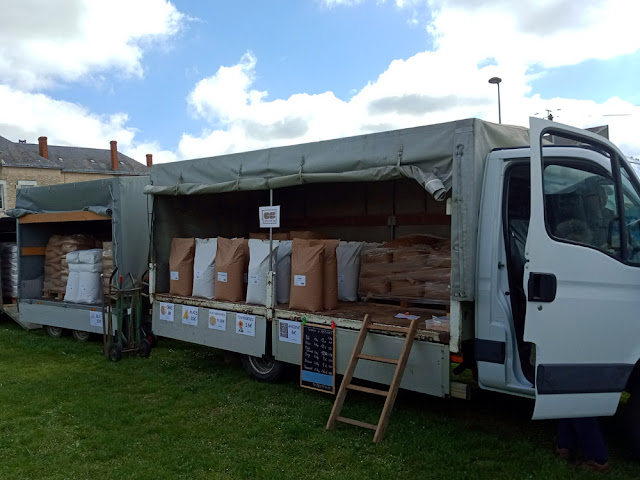The protection worked!
Wednesday, 31 May 2023
Tuesday, 30 May 2023
Three Beautiful Blue Spring Wild Flowers In the Touraine Loire Valley
These lovely and uncommon wild flowers were all photographed on the Eperon du Murat nature reserve near Ferriere-Larcon on 13 May 2023.
 |
| Upright Bugle Ajuga genevensis (Fr. Bugle de Geneve). |
Upright Bugle is probably often mistaken for Bugle A. reptans as it resembles it closely, they hybridise readily and A. reptans is much more abundant and well known. If you see a bugle in an open sunny grassy environment with a brighter lighter blue flower that is your clue that you might have Upright Bugle. Check the stems, which like all plants in the mint family, are square in section. If they are hairy on all four sides then you have Upright Bugle. The species likes dry sunny sites with poor calcareous or neutral soil. The flowers produce lots of nectar and are very attractive to Honey Bees Apis mellifera (Fr. Abeilles des ruches).
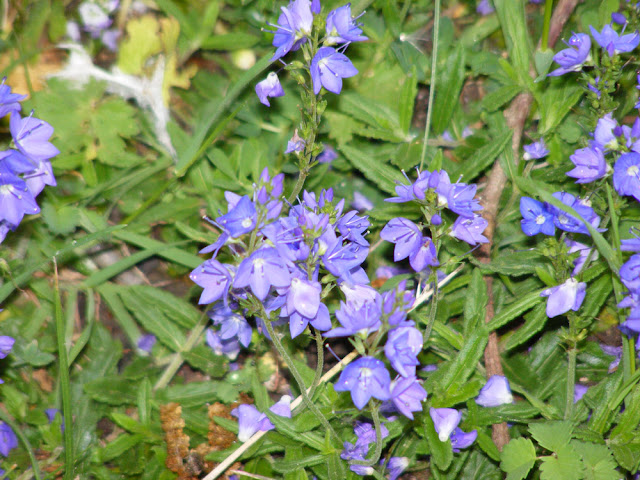 | |
| Veronica orsiniana (Fr. Véronique d'Orsini). Probably. |
This speedwell is not considered threatened, but it is in decline, and uncommon enough in the Touraine that if it is present on a site it can be declared a Zone Naturel d'Interet Ecologique, Faunistique et Floristique (ZNIEFF). Native to southern Europe, it likes hot dry short grassland and woodland edges on poor calcareous soil.
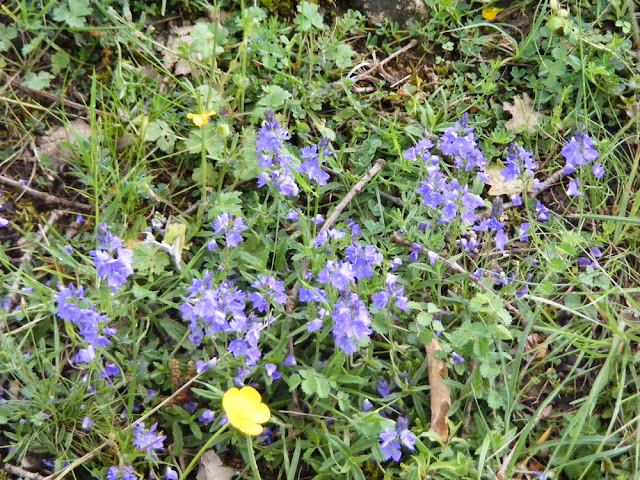 |
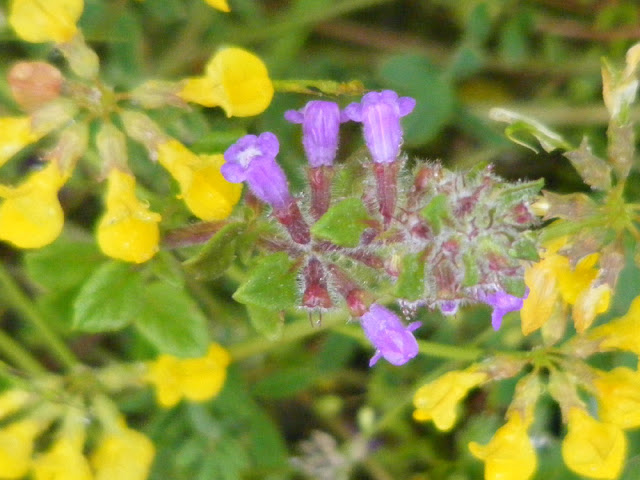 |
| Basil Thyme Clinopodium acinos (Fr. Calament des champs). |
This is an annual or biannual, in the mint family. The leaves are hairy and the flowers are usually pink or mauve but sometimes they are more violet like the ones in the photos, and they often have a white patch on the lower lip.
The species likes uncultivated reasonably warm dry calcareous sites that are mowed annually. You can find it in short grassland, fields and fallow land.
Monday, 29 May 2023
Pruneaux de Tours
This is a repost from May last year, because very few people know about pruneaux de Tours, but may have read how Elizabeth David came to Tours especially to eat the traditional local pork and prunes dish and wondered why Tours should have been so famous for such a dish.
************************************************
Before there were pruneaux d'Agen there were pruneaux de Tours. Pruneaux are prunes ie dried plums. Nowadays the town of Agen in Aquitaine, south-west France, is famous for them, but up until 1970, it was the small oval yellow oven dried whole Saint Catherine plums from around Tours that were the most highly regarded product. Sometimes other small local plum varieties such as Damas de Tours or Rochecorbon (also known as Diaprée rouge) were used. Then in the spring of 1970 there was a tremendous frost which almost entirely wiped out the orchards in the Touraine and production of pruneaux de Tours ceased.
 |
| Sainte Catherine plums in our orchard. |
I learnt all this because my friend Christian has a plum drying oven in his troglodyte cave. It is missing the platform on which the plums would have been arranged on racks to dry, and under which a fire would have been lit. The old Tourangeau variety Sainte Catherine plums are still widely grown in domestic orchards in the Touraine. We have two in our orchard, but they are no longer a commercial variety. Supposedly Eleanor of Aquitaine brought damsons back to France from the Holy Land after the Second Crusade in 1149. Both Sainte Catherine and Agen plums were developed from these original plums. Sainte Catherine plums are found only in Touraine and Burgundy, and likewise Agen has its own variety.
Plums used to do very well in this area, but many people, like us, haven't had a decent crop for several years now due to frost and dry. In the days when there was an over supply most years, drying the plums was one of the most practical ways of preserving them. After all, there is only so much jam one can eat, and what else does one do with plums to preserve them in the days before refrigeration?
 |
| Interior of Christian's prune drying oven. |
Pruneaux de Tours were eaten with goats cheese (of course!), as something to nibble with an aperitif, used to make tarte aux pruneaux, or combined with pork in a traditional Tourangeau dish.
Sainte Catherine plums are ripe in August, and the production of pruneaux de Tours dates from before the 16th century, when Rabelais writes about it. In the 17th century they were all the rage in Paris, and later shipped up and down the Loire to be exported beyond France. The First World War caused a great decline in their production, due to lack of agricultural labour, the appearance on the market of Agen prunes and Californian imports, and changing agricultural practices. By 1930, the village of Huismes, near Chinon, was the last place producing genuine pruneaux de Tours.
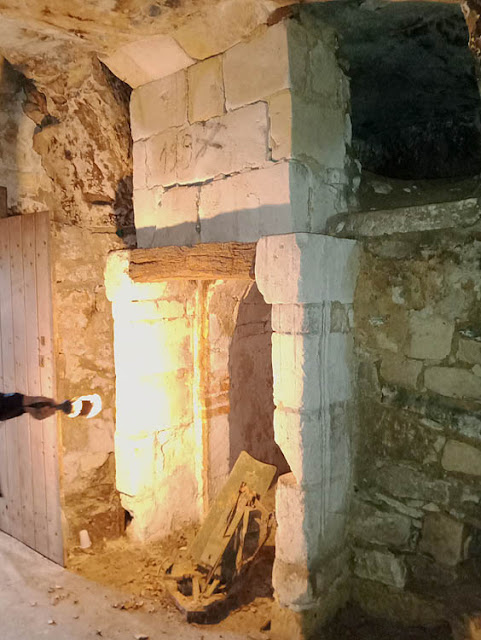 |
| Exterior of Christian's prune drying oven. |
There are some well preserved prune drying ovens at Huismes, and in the early 20th century there was 80 000 tonnes of plums harvested annually in the area around Chinon. A typical orchard was 6 or 7 hectares, with 100 plum trees producing a tonne of dried fruit per year, from 8 ovens.
To process the plums they were first laid in locally made wicker baskets. They were then heated and cooled successively five or six times, over a blackthorn or gorse fire. They were done when the prunes were covered with a fine white powder which was formed by the dessication and deposit of flavour elements in the prunes. It is this bloom, known as 'pruneau fleuri', which made the pruneaux de Tours special.
These days commercial plum orchards are rare in the Loire Valley, but you can still occasionally buy a product labelled 'pruneaux de Tours'. However, the plums have been imported from California, and the product is now specifically a prune filled with almond paste to be eaten as a rather upmarket snack.
Friday, 26 May 2023
Éolienne Bollée
Thursday, 25 May 2023
Three Beetles You Could See in the Touraine Loire Valley in Spring
These beetles all emerge once the days are warm enough and there is enough food for them. In the case of one it needs nice toxic buttercups and wood anemones to be juicy with fresh new spring shoots. In the case of another it needs lots of nutritious pollen on flowers it can burrow into. These were all photographed on the Eperon du Murat nature reserve at Ferriere-Larcon on 13 May 2023.
 |
| White Spotted Rose Beetle Oxythyrea funesta (Fr. Cétoine grise) on a Field Scabious Knautia arvensis (Fr. Knautie des champs). |
The White Spotted Rose Beetle is present practically all over Europe. The larvae are about 30mm long and eat decaying matter and plant roots as well as wood. They live underground until emerging as adults in the spring. When they are newly emerged they are covered with a white bloom which quickly wears off, leaving just the small spots you can see in this photo, and revealing the slightly greeny bronzey black base colour. The adults are considered a pest by gardeners and orchardists as they don't just eat pollen, but sometimes whole buds. Their favourite flowers are fruit tree blossom, roses and irises, and they are particularly attracted to pale coloured flowers. They only have one natural predator, the parasitic Hairy Scoliid Wasp Scolia hirta (Fr. Scolie hirsute), a species which is in decline, resulting in White Spotted Rose Beetles being increasingly abundant. Treating them with an insecticide is ineffective, so if they are causing unacceptable damage in your garden, the best way of dealing with them is to pick them off in the early morning, when they are too cold to evade you, and taking advantage of how visible they are on pale flowers.
 |
| Violet Oil Beetle Meloe violaceus (Fr. Méloé violet), female, on a buttercup Ranunculus sp (Fr. Renoncule). |
Violet Oil Beetles are parasites of bees and they have quite a complicated life cycle. Females like this one can be recognised by their hugely distended abdomens. The first stage larvae are called triangulins. They are equipped with large flat hooked feet which allow them to scale a flower stem and lie in wait for a bee to latch on to. The second stage larvae look like ground beetle larvae and they live in the bee's nest. During their next stages they look like chafer larvae. At first they eat the food supplied by the bees for their own larvae, then they are more mobile and become carnivorous. For their final two stages they bury themselves in the ground and finally transform into an adult beetle. The adults live in flower rich meadows, on forest tracks and woodland edges. They are very visible in the early spring, on the ground, when they are feeding or digging holes in which to lay their eggs. If the beetle feels in danger it will release a toxic orange liquid from its mouth. Both larvae and adults are toxic, as a result of the adults eating toxic Ranunculus spp. The species is considered to be threatened, and although not protected in France, they are monitored carefully.
 |
| Rustic Sailor Beetle Cantharis cf rustica (Fr. Moine) on Dogwood Cornus sanguinea (Fr. Le Cornouiller sanguin). |
The Rustic Sailor Beetle is abundant in Europe, from France to Russia, found in forest clearings, prairies and woodland edges. It is a carnivorous species, visiting flowers, especially umbellifers, to hunt other insects attracted by the flowers. The photo is probably this species, but there are other lookalikes and I can't be sure of the identity from this photo alone.
Wednesday, 24 May 2023
Book Now
This is not an exhortation to book a tour with us (although that would be nice), but a reminder that some attractions in France have timed entry.
This restricts the number of visitors each day: if there is somewhere you really must see and it's somewhere that does timed entry, book as soon as you can.
Last Friday Chenonceau was full. If you arrived hoping to get in and didn't have a ticket you were out of luck.
Tuesday, 23 May 2023
An Outing to the Touraine's Top Orchid Site
On 13 May 2023 the Association de botanique et de mycologie de Sainte Maure de Touraine had an outing to the Eperon du Murat at Ferriere-Larcon, led by orchid expert Marc Fleury. The site is a managed nature reserve in the care of the Conservatoire des Espaces Naturelles de la Val de la Loire. It consists of a limestone ridge with rough grassland grazed by sheep and dominated by juniper and downy oak on the steeper bits. Across one end of the site is a prehistoric defensive wall. The weather was distinctly iffy, and after a couple of hours on the north side of the site we got hailed on and very wet. Nothing daunts a keen naturalist though and off we went to check out the south side of the site. Seventeen species of orchid were recorded, plus three hybrids and two hypochromatic mutations.
 |
| Lady Orchid Orchis purpurea (Fr. Orchis pourpre). |
 |
| Buckthorn Rhamnus cathartica (Fr. Nerprun purgatif), an uncommon species. |
 |
| A hypochromatic Monkey Orchid Orchis simia (Fr. Orchis singe) with a ruby-tailed wasp Chrysidae. |
 |
| Marie-Claude photographing a Monkey x Man Orchid hybrid, with lots of Monkey Orchids visible in the grass. |
 |
| Burnt-tip Orchid Neotinea ustulata (Fr. Orchis brulé) and Monkey Orchid habitat. |
 |
| The very last Small Spider Orchid Ophrys araneola (Fr. Ophrys petite araignée) on the site. They have died out in the past three decades. |
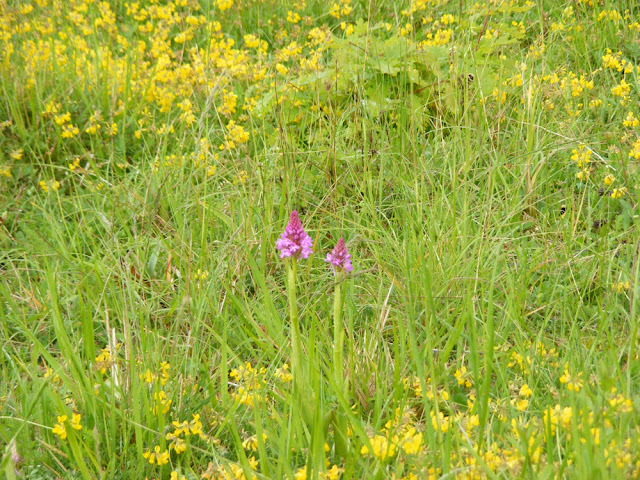 |
| Pyramidal Orchid Anacamptis pyramidalis (Fr. Orchis pyramidal). |
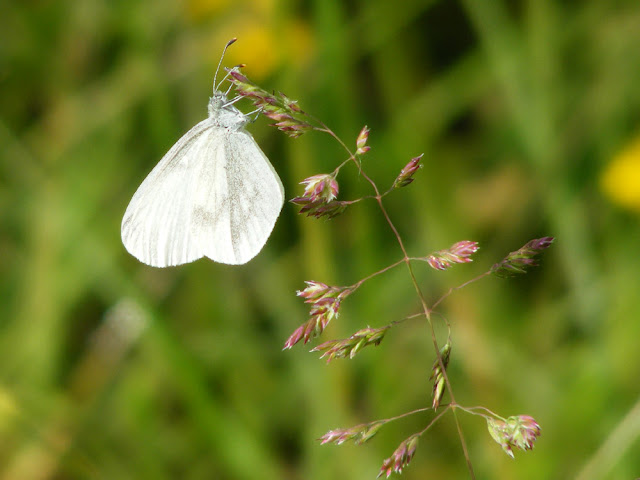 |
| Wood White butterfly Leptidea sinapsis (Fr. Piéride de la moutarde). |
 |
| Male Adonis Blue Polyommatus bellargus (Fr. Azuré bleu céleste). |
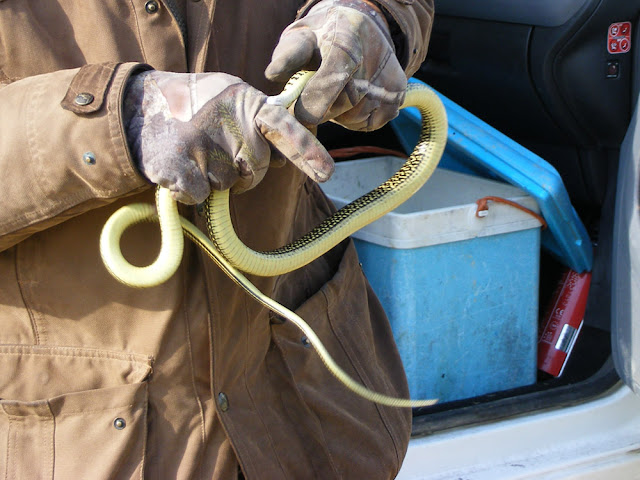 |
| Marc released this young Western Whip Snake Hierophis viridiflavus (Fr. Couleuvre verte et jaune) that he had captured in his chook shed. |
 |
| Since the weather was unreliable, Marc gave his introductory talk in the church. |
Monday, 22 May 2023
French Bars, Cafes and Bistrots
The numbers of cafés in France have tumbled, according to a recent study. In 20 years over a quarter of Parisian cafés have disappeared. A symbol of the French 'art of living', they have gone from 1907 in 2002, to 1410 in 2022. France wide, there were 600 000 bistrots in 1960, and 35 000 in 2016. Similar has happened to the roadside restaurants known as routiers. In 1980 there were 4500, today only 700. These types of cafés which operate as bars and bistrots are one of the most iconic aspects of French life, and if they are on the way out, then so is the morning coffee taken at the comptoir, the demi of draught beer in the late afternoon after work and the aperitif in early evening. In the old days this is where you picked up a 'casse-croute' (snack) such as a jambon beurre (ham in a buttered baguette) if you were pushed for time and needed to eat. Another popular snack was a hard boiled egg, which you took from a rack on the bar and banged against the 'zinc' to shell, until it was deemed unhygienic and the practice ceased. Children might have a boiled egg and a glass of milk with grenadine syrup, or a diabolo menthe (mint with limonade). Adults might have a vin limé (wine and limonade) in the summer, or a café-calva (coffee with calvados) in the winter. (Limonade is a still clear sweet drink and is not lemonade.)
 |
| Preuilly was briefly amongst those villages that had lost all its cafés and bars. This is the good old days, at l'Image, with the Chedozeau brothers behind the bar. |
And it is where innumerable conversations on innumerable topics between friends, strangers, and visitors take place. It is where French people would have had their first taste of Coca Cola, in the 1950s. And in the 1960s, televisions appeared, so clientele could watch press conferences with General de Gaulle or the horse races at Longchamp. In the mid-20th century, people would not have had a coffee machine at home and only have consumed Coca Cola at the café, not at home.
 |
| This bar, offering casses-croutes, is in the market hall at Saint Jean de Luz. It offers a robust ambiance not for the faint hearted tourist, but beloved by the regulars. |
The 16th arrondissement in Paris is the most affected, with the loss of 68% of its bars and cafés, followed by the 19th (60% loss) and the 8th (58% loss). Only two arrondissements have increasing numbers of bars and cafés. The 2nd has 17% more and the 3rd has 15% more, due to how popular with tourists they are. Concurrently, fast food outlets and coffee shops are multiplying, and it is this which is contributing to the demise of the bar/café. In the 8th arrondissement there is a 90% increase in the number of fast food outlets, and in the 3rd, an 86% increase. Nowadays, the clientele of cafés and bars are not so much workers, who can't afford them any more, but tourists. The bistrots have become brasseries, the cafés have turned into trendy tea rooms.
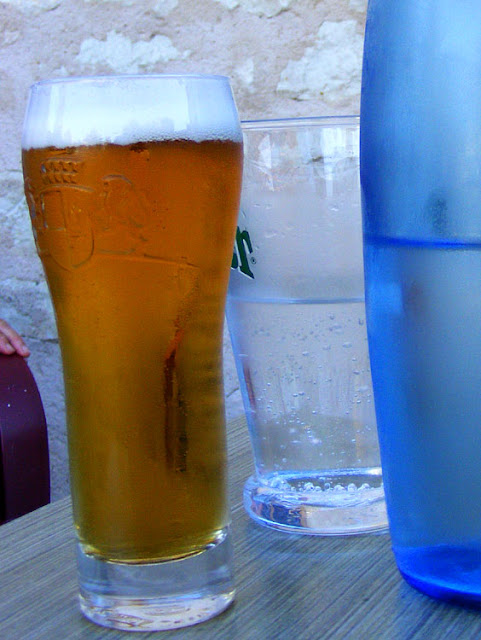 |
| A galopin (125 ml) of draught beer at a bar restaurant in the Touraine. |
But the rise of fast food outlets is not the only reason bars and cafés are disappearing. French workers are taking less time for lunch, not working in the centre of town, and the pandemic didn't help. Many clients have not returned to their old haunts because they now work from home. Even when bars were allowed to reopen once it was deemed safe, initially customers were not allowed to stand at the bar, and that changed consumption patterns too.
 |
| A typical local bar in Preuilly, now also closed. L'Esperance is, or was, opposite the Abbey, and closed in August 2022. |
Ironically, one of the great advantages of the old style bar is the speed of service. Nowadays it is more usual to seat yourself at a table, then wait for the server to come to take your order, and again for them to come with the card machine at the end of your sojourn. Not so good for anyone who just wants a quick drink and has told their wife they are just nipping out to get the daily baguette.
 |
| Le Garage in Saint Jean de Luz, a modern bar which succeeds in being both community oriented and buzzy enough to entice tourists in. |
Sometimes the problem is that bars are in rented premises and the landlord decides to sell the real estate for re-development.
The bar counter is known as a comptoir, often referred to as le zinc. These 'zincs' appeared at the end of the 19th century. They were always set up so they were exactly the right height for a man standing at the bar to lean his elbows on, 110 mm. Even once drunk, men could retain a dignified appearance, propped up by their elbows. Typically the 'zinc' covered bar would be equipped with a beer pump and behind the bar, underneath, there would be refrigerators, with a coffee machine on the other side. Nowadays, many bars are set up in such a way that does not encourage customers to stand propping them up in the old way. Now they are expected to take a table.
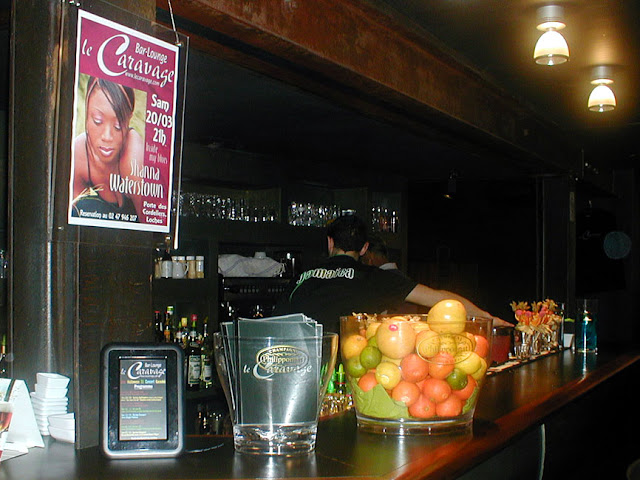 |
| Le Caravagge in Loches, where they do intimate jazz concerts and great mocktails. |
The 'zinc' of the bar is in fact galvinised (zinc coated) steel. Many old 'zinc' bars didn't survive the German occupation of the Second World War. They were requisitioned by the Germans to melt down for munitions. They made a bit of a comeback in the Trente Glorieuses (the 30 years post-World War Two, when France experienced economic growth) but by then formica was the fashionable work surface treatment. Nowadays the 'zinc' (or brushed stainless steel) is back in fashion and formica out, and the patina and lustre of the metal much admired for its practicality, durability and attractiveness.
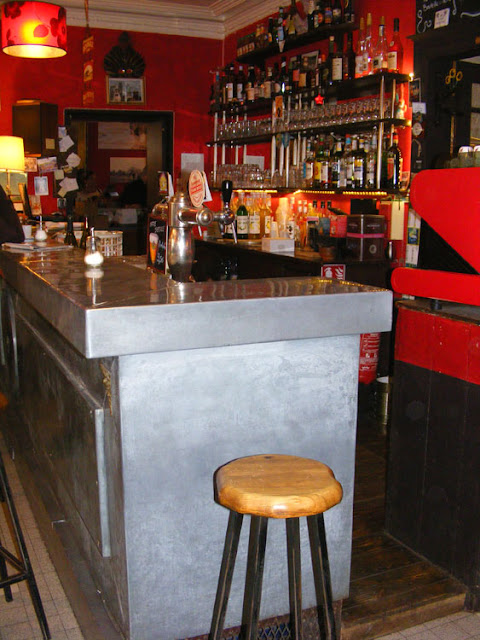 |
| A restored zinc bar in Berry. |
In the 1930s there was one bar/café/bistrot for every 85 people. Nowadays it is one for every 1500 people. In the inter-War years these places were where you went for life milestone celebrations (promotions, weddings, birthdays, retirements).
In the early 20th century, absinthe was cheaper than wine. The outlawing of absinthe in 1914 brought a significant reduction to the prosperity of bistrotiers (café owners), as did the outbreak of war and the mobilisation of their clientele (not to mention that so many of them never came back...). It prompted the Pernod brothers to develop the first aniseed flavoured pastis.
Some of the drinks were creatively named (or nicknamed). A 'fond de culotte' is the bitter orange aperitif Suze with cassis (blackcurrant liqueur). It's a sort of French version of Cockney rhyming slang: 'car le fond de culotte ne s'use qu'assis !' (because the seat of the trousers only wears out when sitting, and 's'use qu'assis' is pronounced the same as 'Suze cassis'). A 'soutien gorge' was milk with strawberry syrup, so named because it was the same colour as bras (Fr. soutien gorge) of the time, although sometimes this drink was called a bébé rose (pink baby). A beer is usually a chope (500 ml) or a demi (250 ml), but could be a galopin (125 ml), and can be adulterated with a syrup or cut with limonade like a shandy, in which case it's called a panaché.
Generally speaking, a bistrot is a bar which offers simple dishes, which could be served at the bar. In other words, a pub which offered counter meals.
The etymology of the word 'bistrot' is still disputed. Some people think it is a corruption of a regional word which arrived in Paris in the 19th century. It might come from a Poitevin word 'bistraud', which initially meant a domestic servant, then came to mean a wine merchant. Or it might come from the northern French word 'bistouille' which is a coffee with eau-de-vie added. Or maybe it is from 'bistingo' a slang word for cabaret.
But the popular legend of the word's origin is that it comes from the Russian occupation after the campaign of 1814. The cossacks, stationed in Paris after the fall of Napoleon, would while away their time in the cafés. Fearing discovery by their officers they would cry 'bistro! bistro!', meaning 'quick! quick' when they wanted a drink. The exoticism of the word appealed and many cafés were renamed. The problem with this explanation is that it appears that the first usage of the word only dates from 1884.
And maybe it is 'bistroquet', which is actually a portmanteau word, combining 'bistrot' and 'mastroquet' or 'troquet', a 19th century word from the Flemish for 'cabaret master' or 'bar', and first used in 1926.
Women who remember the good old days of traditional 'zincs' are not always so overcome with nostalgia. They were a haven for alcoholism, and definitely male dominated. And of course, the smoking ban has inevitably altered the atmosphere in these places, with conversations being interrupted whilst the smokers exit for a quick desperate drag (or no longer frequent their local bar at all).
Friday, 19 May 2023
Capturing Wildlife
When we first bought this house Susan was excited when she noticed "an orchid" (unspecified) in the garden.
Over the next few months we learned about the orchids of the Loire Valley, but we never saw our orchid bloom. I had inadvertently mowed it, trodden on it, or driven over it - or all three - and as far as I can recall since then we have never had a really strong orchid in our garden.
This year I am determined to reverse that. For the past goodness knows how many years we have had a lizard orchid rosette by our back gate, but either the gate or us have managed to squash it. This year will be different.
Our old ash bin finally totally rusted out a year or so ago, and one of the winter storms rolled it into the garden. That's when inspiration hit.
We will now see "our" orchid, protected as it is from feet, wheels and over zealous lawn mowing.
I don't think about gardening often, but when I do, I think good.
Thursday, 18 May 2023
Windy!
Wednesday, 17 May 2023
That's Random
Regular readers will recall we are semi-regular attendees at the annual Martizay Goose Fair held on May 2nd (we have written about it here, here, and here). I can't remember if the fair was on last year, we certainly didn't go, I think we were working.
This year we called in for a stroll and lunch, expecting carp, but the Brenne association didn't appear to be there. Instead we had lunch from a traiteur we have seen at various fairs and fetes. Susan had duck and I had merguez. No idea who they are or where they're from, but it was good.
The fair is a sign that spring is here and we should be thinking about summer veg. The plant stores were doing roaring trade, as were the various greengrocers. The agricultural merchants were out in force selling stock feed, tools and tractors, but as far as we could tell there was only one stall offering feathered livestock.
There was also some entertainment.
It's surprising what you can see in a small French village.
Tuesday, 16 May 2023
It Rained (Again)
On Saturday it rained again. This time we were at home, so I thought I would make a video of the street flowing, just to dispel the received wisdom that it never rains in Preuilly.
I hope it works. As usual, blogger and YouTube have changed everything.
Monday, 15 May 2023
A French Funeral Followed by a Ukrainian Feast
 |
| A nice photo of Valery, with borscht, vodka and pyrizhky for the deceased. |
A couple of weeks ago I got a WhatsApp message first thing in the morning. It was from Christiane, in shock, telling the group of us who assist our local refugee community that Valery had died the night before. A few days earlier he had been hospitalised after heart problems manifested themselves, but he had been released, with a date for surgery. Sadly, he had a heart attack and died before the surgery could be performed. He and his wife Lyubov were amongst our first Ukrainian refugees, arriving almost exactly 12 months earlier. He was well liked and recognised in the village, always with a big smile and a friendly greeting, even if he didn't share a language with you.
 |
| Outside the crematorium in Chatellerault. |
Valery was born on 24 February 1959 in the city of Mykolaiv. He married Lyuba, from Kherson, in 1980 and they had two sons, Volodymyr and Maxim. Lyuba told me that they met because she worked with his mother. It was love at first sight. He died the day before their forty-third wedding anniversary. One of their sons is on the front line, defending Ukraine. The other lives in Romania and was able to make it to the funeral. When Valery first arrived in Preuilly he had his grandson with him, but the boy never adjusted and missed his parents so much that he was finally taken back to his mother in Ukraine after just a few months in exile.
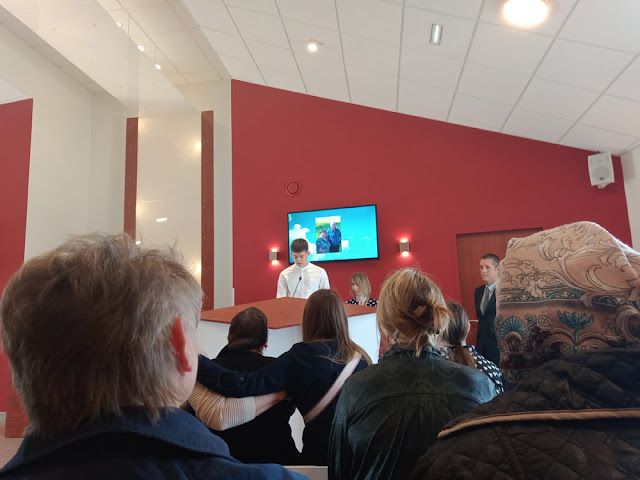 |
| Makari delivered the eulogy in Ukrainian, and Nina translated into French. |
Valery had constructed three family homes and created two food businesses in Ukraine. Latterly he and Lyuba ran a café, but before that he had a meat smoking business. Once established in Preuilly he was one of the first of 'our' refugees to get a job, at a Ferme Auberge where they raise poultry, process them and sell their product direct to the public from the farm shop and farm restaurant.
 |
| Ukrainians preparing the post funeral feast. Four of the people in this photo are called Natalyia. |
He was one of those people who was always full of ideas, and would always respond to requests for help. When the war broke out he organised to evacuate women and children, driving them 3000 kilometres in his car. Four of 'our' Ukrainian families have him to thank for getting them to safety. He was always very positive, fun loving, cheerful and smiling, never complaining, and was an absolute rock for our refugee community.
 |
| Ukrainian borscht and pyrizhky. |
Cremation is the norm in France, although I gather it is not in Ukraine. Sadly, it just wasn't an option to transport his body back to Ukraine and bury him there, and without a family burial plot in France, cremation was the only practical option. So everything was organised with the local funeral directors and the crematorium in Chatellerault. Christiane and Nina were marvellous, sorting out a set of clothing for Valery to be buried in and accompanying Lyuba at every stage. She went to stay with one of the other Ukrainian families until their son Maxim arrived. I went over to sit with her and found her taking phone call after phone call from Ukraine. The older Ukrainian women were there keeping her company, and Natasha, her distant cousin, whose apartment we were in, was in pieces.
 |
| Ukrainian pyrizhky, kotleti and mashed potato. |
Lyuba wanted to have a traditional Ukrainian meal after the funeral service, so the village hall was booked, crockery borrowed from the Comité des fetes, and our Ukrainian community cooked up a storm to feed about 50 people with borscht, pyrizhky (buns stuffed with cabbage and onions), salads and crudités, smoked herring, mashed potato, kotleti (pork rissoles) and kutia (a sort of rice pudding). Valery was toasted in horilka (vodka) and there was homemade uzvar (dried plum cordial). I sat with Anna from Dnipro, Valery's boss from the poultry farm, various French volunteers and the Ukrainian adults French teacher, Carlos.
 |
| Smoked herring and vodka, a traditional pairing apparently. |
Lyuba decided to leave with her son Maxim after the funeral rather than stay on her own in Preuilly. She has permission to take Valery's ashes with her.
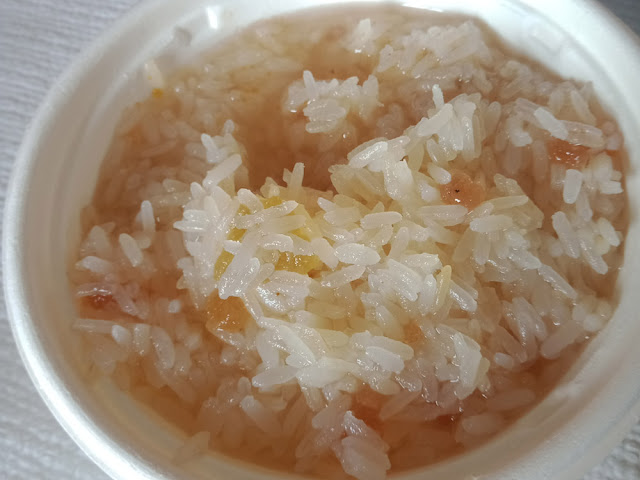 |
| Kutia. |
 |
| The funeral feast. |
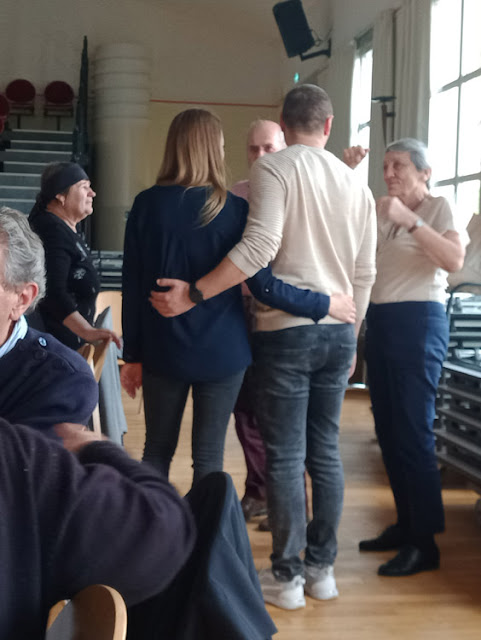 |
| The mayor popped in to offer his condolences to Lyuba on the left, her son and his wife, with Christiane making the introduction. |











